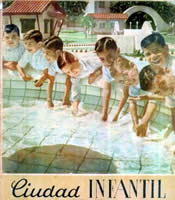 The
Children’s City was not an amusement park although it brought joy
to thousands of children. It was a safe haven for children whose parents
were experiencing difficulties and needed long or short term help with
child care. As such, La Ciudad Infantil functioned in much the same way
as the Hogares Escuelas (see article on this website), having both day
students and residents. A motto from the Peronista Golden Age - those
early years of Perón’s first Presidency when The
Children’s City was not an amusement park although it brought joy
to thousands of children. It was a safe haven for children whose parents
were experiencing difficulties and needed long or short term help with
child care. As such, La Ciudad Infantil functioned in much the same way
as the Hogares Escuelas (see article on this website), having both day
students and residents. A motto from the Peronista Golden Age - those
early years of Perón’s first Presidency when 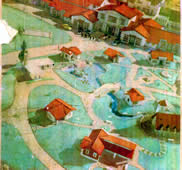 Evita
was alive and everything seemed possible- proclaimed that “the only
ones with privileges are the children.” Evita wanted the children
to be not only privileged but protected. Her Fundacion wove a safety net
stretching from childhood (the Hogares Escuelas for primary school children),
to adolescence (the Ciudad Estudiantil for secondary school children)
and beyond (the Ciudad Universitaria). Evita
was alive and everything seemed possible- proclaimed that “the only
ones with privileges are the children.” Evita wanted the children
to be not only privileged but protected. Her Fundacion wove a safety net
stretching from childhood (the Hogares Escuelas for primary school children),
to adolescence (the Ciudad Estudiantil for secondary school children)
and beyond (the Ciudad Universitaria).
The Ciudad Infantil, which sheltered children from two to seven years
of age, held an enchantment all its own. Social workers referred children
on a needs basis as stipulated by the Ciudad’s charter (very similar
to that of the Hogar Escuelas). At capacity, the Ciudad could take in
450 children; on an average, it held around 300, including residents and
day students.
The Children’s City was the apple of Evita’s eye. There she
could see the fruit of the sacrifices she was making in her own life.
Visitors from other countries commented that it was a model establishment,
well ahead of its time; its aim was to integrate marginalized 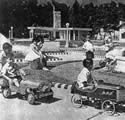 children
into society, prepare them for school and help them develop healthy relationships
by means of play. children
into society, prepare them for school and help them develop healthy relationships
by means of play.
When people remember the Children’s City, they inevitably think
of its miniature buildings: chalets, the plaza with its splashing fountain,
the school, city hall, 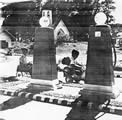 the
Nordic style church with its vitraux, the gas station where pedal cars
were driven up to the pumps and the attendant was told to “fill
it up” , the police station where speeders were issued tickets,
the bank and shopping center with its assorted stores (pharmacy, greengrocer’s,
grocery store), and the azure stream which meandered through the city.
In the Children’s City, everyone had the chance to be mayor, banker,
pharmacist or teacher, but only for a day. Occupations were rotated, so
that each child could fulfill different roles in the community. the
Nordic style church with its vitraux, the gas station where pedal cars
were driven up to the pumps and the attendant was told to “fill
it up” , the police station where speeders were issued tickets,
the bank and shopping center with its assorted stores (pharmacy, greengrocer’s,
grocery store), and the azure stream which meandered through the city.
In the Children’s City, everyone had the chance to be mayor, banker,
pharmacist or teacher, but only for a day. Occupations were rotated, so
that each child could fulfill different roles in the community.
But the Ciudad Infantil was much more than a collection of miniature buildings.
The entire City occupied two blocks, bordered by four streets: Echeverria,
Húsares, Juramento and Ramsay in the Barrio Belgrano, a suburb
of Buenos Aires. One block was a large tree-shaded playground with slides,
teeter-totters, sandboxes, merry-go-rounds and an electric train. The
other block held the main building which housed the administrative offices,
a clinic, school rooms, a dining room with a capacity for 450 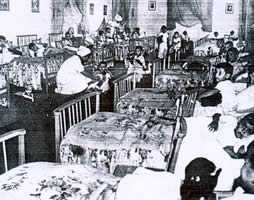 children,
four dormitories with a capacity for 110 children, a circus, a large hall
and a theater. Outside were solariums, a swimming pool and the miniature
city (an adult wishing to enter the buildings of the miniature city had
to stoop). children,
four dormitories with a capacity for 110 children, a circus, a large hall
and a theater. Outside were solariums, a swimming pool and the miniature
city (an adult wishing to enter the buildings of the miniature city had
to stoop).
Walls in the main building were decorated with drawings of the characters
familiar to children down through the ages: Little Red Riding Hood, Cinderella,
the Three Little Pigs, circus animals. The dining room ceiling was scalloped
so it wouldn’t seem so high, and all the rooms were bright, spacious
and airy.
The children’s clothing came from the best shops in Buenos Aires
and was changed every four months. Children with shaven heads wearing
the drab uniforms of the Society of Beneficence had no place in the New
Argentina.
One detail illustrates the quality of care the children were given. The
dining room tables had tablecloths of three different colors, but the
yellow, pink and blue cloths were not part of a decorator’s color
scheme. The children were divided into three groups as recommended by
their dietitians. The caloric value given to the resident students was
based on their height and weight and contained the vitamins, minerals
and protein they needed to meet 100% of their daily requirements. The
day students, who might not be given a sufficient amount of nourishing
food at home, received 90% .
The children went to the Children’s Hotel in Chapadmalal for summer
vacations where many of them splashed in the Atlantic Ocean for the first
time in their lives.
If the home situation had not improved by the time the child was ready
for school, then that child was given priority of placement in a Hogar
Escuela.
Construction of the Ciudad Infantil went on day and night for five months
and twenty days. It was completed in record time and inaugurated on July
14, 1949, surely one of the happiest days of Evita’s life as wife
of the President. The old newsclips show her whirling around, almost dancing,
as she points out its features to those attending the inauguration. The
workers who had clocked the most hours presented her with “the keys
to the city” and told her that they knew that they were 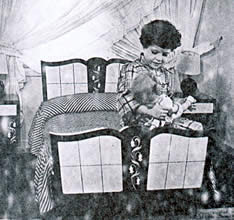 working
for the good of their own children when they worked for the Fundacion.
The City was named “Cuidad Infantil Amanda Allen” after one
of the Fundacion nurses killed in a plane crash as she returned from helping
the victims of an earthquake in Ecuador. working
for the good of their own children when they worked for the Fundacion.
The City was named “Cuidad Infantil Amanda Allen” after one
of the Fundacion nurses killed in a plane crash as she returned from helping
the victims of an earthquake in Ecuador.
Her sister Erminda relates an anecdote which shows that the Ciudad Infantil
was never far from Evita’s thoughts. One day an elderly man went
to ask her to help him find work. “I really like the country,”
he stated. Evita felt that farm work would be too hard for him at his
age, so she told him, “I need you in the city. And I am going to
give you a job. I have been given three little donkeys for the children
of the Cuidad Infantil to ride on and I want you to take care of them
for me.” Erminda says that taking care of those donkeys made him
the happiest man alive.
Evita often visited the City unannounced, day and night. She would check
to see if there were enough supplies and ask for children by name if she
missed seeing them. Erminda relates how, when she knew she was dying,
she escaped from her doctors and went to visit the Ciudad Infantil. When
she returned to the Residence, she cried as she told her sister that the
level of care she had always insisted on was not being maintained.
After the military coup of 1955, the children in residence were evicted
and the establishment was turned into a nursery school for the children
of the upscale Belgrano neighborhood. Later the AntiInfantile Paralysis
League took over the administration buildings. In 1964, the author of
this article found out that the miniature city was scheduled for demolition
and appealed to the newspapers and magazines most sympathetic to the workers
whose contributions had made its construction possible. Newspapers wrote
articles, but the public had no power to stop the destruction and the
buildings were razed to make way for a parking lot.
What happened to the Ciudad Infantil is symbolic of the destruction of
Evita’s works. In the Argentina of the third millennium, children
are no longer privileged. Indeed, in a country capable of producing enough
food to feed the entire population of the United States, Argentine children
today are dying of starvation.
After the military took over Argentina in 1955, Evita’s works were
systematically destroyed or given other uses more in accordance with the
philosophy of the once again ruling classes (for instance, the military
turned the Children’s Hospital in Terma de Reyes into a luxury hotel
and casino for themselves and their families). As a reason for justifying
the dismantling of the Ciudad Infantil, the military investigative team
issued a report on December 5, 1955. We give them the last word: “The
attention given to the minors was varied, even sumptuous. One could even
say excessive and not at all in accordance with the sobriety which should
be part of the austere formation given to the children of a republic.
Fowl and fish formed a daily part of the children’s diet. And as
for clothing, their wardrobes were renewed every six months and the old
clothing destroyed.”
Bibliography
Ferioli,
Néstor. La Fundación Eva Perón / 2. Buenos
Aires:Centro Editor de América Latina, 1990.
Fraser, Nicholas
& Marysa Navarro. Evita: The Real Life of Eva Perón.
New York: W.W. Norton & Company, 1996.
Ortiz, Alicia
Dujovne. Eva Perón. New York: St. Martin’s Press,
1996.
Fundación
Eva Perón. Eva Perón and Her Social Work. Buenos
Aires: Subsecretaria de Informaciones, 1950.
La Nación
Argentina: Justa, Libre, Soberana. Buenos Aires: Ediciones Peuser,
1950.
|





